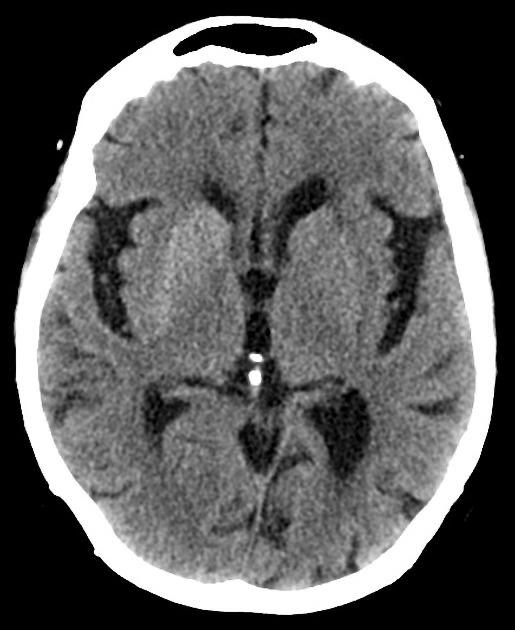Category: Choreas (Non-Huntington's Disease)
Objective: Discuss a case of Non-ketotic hyperglycemia hemiballismus hemichorea that preserves the subthalamic nucleus (STN).
Background: Non-ketotic hyperglycemia hemiballismus hemichorea is a pathology characterized by involuntary movements of the throwing type, intense, abrupt, non-rhythmic and unilateral, usually related to elderly patients with poor glycemic control.
Method: 52-year-old male patient, conscious, was admitted to the emergency with choreic, involuntary abrupt movements using the proximal and distal muscles of the left hemibody. He’s been a smoker since the age of 20 with a tobacco rate of 20 packs/year. He denies alcoholism and hás a history of type 2 diabetes mellitus, systemic arterial hypertension and dyslipidemia. Fasting blood glucose levels was 26 mmol/L and HbA1c was 15,3%. Not reportes stroke or previous trauma. Physical and neurological examinations were performed, showing low-amplitude choreoathetosis in the left lower limb, without muscle weakness, and negative dysarthria, ataxia, postural instability and myoclonus tests.
Results: In the contrast-enhanced axial cranial CT image, there was related image hyperdensity of the basal ganglia on the right, resulting from non-ketotic hyperglycemia. There is no change in the STN region. CT does not show hypertensive hemorrhage, as there is no effect of mass effect, edema or volume loss, ruling out differential diagnoses such as stroke and TBI. Alterations in the STN, although common in patients with hemiballism, are not pathognomonic of the disorder, corroborating the finding of the patients images, as the STN are preserved, contributing to the hypothesis that the movement disorders found do not result from theses alterations that are classically relationed.
Conclusion: The patient in this case presents hyperglycemia, which causes perfusion changes and ischemic excitotoxicity of GABAergic neurons, resulting in an excessive inhibition of the subthalamic nucleus and an excitatory cortical discharge. In a review by The Lancet, Ronald and Anthony, showed that STN are altered in only a minority of cases of hemiballism, suggesting that lesions in other áreas can lead to this disorder. The patient was treated for glycemic control, with clinical resolution in four days, which persisted over the following months. Therefore, considering the other inhibitory pathways of GABAergic neurons may improve treatment prognosis compared to the previous theory of direct damage to STN.
To cite this abstract in AMA style:
A. Aguiar, I. Duarte, J. Jucá Neto, G. Do Nascimento, J. Dos Santos. Hemichorea-hemiballismus syndrome without damage to the subthalamic nucleus? [abstract]. Mov Disord. 2022; 37 (suppl 2). https://www.mdsabstracts.org/abstract/hemichorea-hemiballismus-syndrome-without-damage-to-the-subthalamic-nucleus/. Accessed April 18, 2025.« Back to 2022 International Congress
MDS Abstracts - https://www.mdsabstracts.org/abstract/hemichorea-hemiballismus-syndrome-without-damage-to-the-subthalamic-nucleus/

